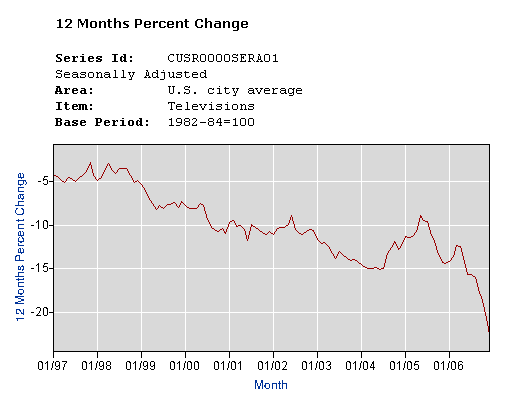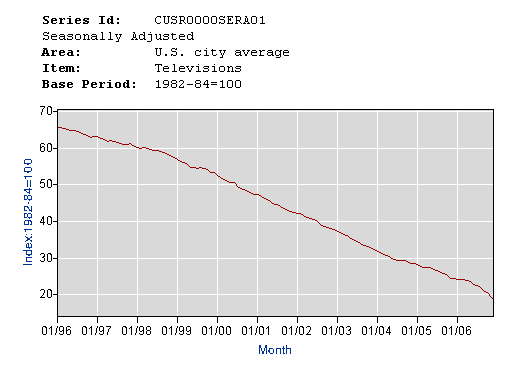Da Bears and Da CPI
Sunday, January 21, 2007
Sometimes it really is hard to argue with at least one type of quality adjustment that the Bureau of Labor Statistics performs when preparing the Consumer Price Index - the quality of television sets has certainly improved over the last ten years while prices have continued to go down.
It's not clear when first looking at the chart below whether the combination of lower prices and more features is accurately reflected there. Those are some pretty steep yearly declines in "quality-adjusted" prices - especially in the last year. Going back to the mid 1990s, "quality-adjusted" prices have fallen by more than two-thirds.
Going back to the mid 1990s, "quality-adjusted" prices have fallen by more than two-thirds.
Is that a fair way to measure prices? What if you had a 27 inch set in 1996 and just wanted to buy a new 27 inch set ten years later?
It's hard to imagine that the new price would be one-third the old price, but you'd get a flat screen, maybe a few more jacks on the back, and probably a few other extras, but the price wouldn't have dropped this much. Well, watching the Bears beat the Saints on a big HDTV with a DVR that allows the viewer to effectively watch the game in less than an hour - that makes a pretty convincing case that at least some of the quality adjustments are very real.
Well, watching the Bears beat the Saints on a big HDTV with a DVR that allows the viewer to effectively watch the game in less than an hour - that makes a pretty convincing case that at least some of the quality adjustments are very real.
How do you measure the quality improvement of the 30-second advance where you can watch a three and a half hour football game in about 45 minutes, zipping through all of the huddles and most all the commercials, pausing only occasionally to catch a new Bud Lite ad?
Our mid-1990s, 150 lb 35 inch TV now sits in the spare room awaiting its fate while the new, embarrassingly large bigscreen HDTV occupies its old spot - a big, beautiful picture that really can't be compared with what it replaced.
Yet the BLS has found a way to factor that into the change in prices that consumers pay.
Does anyone really need a TV or a digital video recorder that is this good?
That's probably the wrong question to ask.











![[Most Recent Quotes from www.kitco.com]](http://kitconet.com/charts/metals/gold/t24_au_en_usoz_2.gif)
![[Most Recent Quotes from www.kitco.com]](http://kitconet.com/charts/metals/silver/t24_ag_en_usoz_2.gif)
![[Most Recent USD from www.kitco.com]](http://www.weblinks247.com/indexes/idx24_usd_en_2.gif)

11 comments:
Wouldn't it be nice if we could have access to a "hedonic adjustment multiplier?" That is, if one wanted to ignore quality adjustments, one could use the hedonic adjustment multiplier to calculate the actual price change of a 32" television.
Certainly, if we believe in keeping statistics, we want to keep track of quality improvements. And we should try and measure them. But it's a really hard thing to objectively measure quality. Thus I ask, do we really want to be lumping quality changes into our CPI numbers? I think the two statistics should be tracked separately.
The CPI should measure prices. A QI (Quality Index) should measure quality improvements.
ChessPlayingAustrian:
I've been harping on about that for a while now. I totally agree.
Interestingly, such a metric would have almost no use outside of academic historical economics.
Yet there it is, polluting our vital economic statistics.
This is exactly what an inflation measurement should NOT measure.
What I really want to know is what fixed things cost over variable time. An egg, a steak, a knife, a house, whatever.
I can figure out the video bandwidth separately!
When you consider how much time and effort it took a caveman to clear out a cave, and compare that to the effort of signing a 'liar's loan' and sitting in a foreclosed house for free for a year, the cost of housing is zero.
I am with Mr. Ponzi. CPI should be based on basics for survival. Hedonics are just a fudge factor to lie the American Public so that Social services and entitlements are kept at reasonable(?) levels.
Housing, Transportation, Food, Clothes, and Education should be the general categories covered (I am probably missing some).
I also think replacing chicken for beef as a hedonic adjustment is just wrong because while people do that chicken does not equal beef and as such loses inflation felt by the consumer.
The real question that should be asked is "what is the alternative". If you had the option of buying something 10-times better at the same price, and buying the original at one tenth the price, then it would matter. But no-one will stay in business selling anything at the lower price, so a customer has to shell out for the spiffier product in spite of the quality increases.
I can buy a sharp 27" 'regular' tv from bestbuy for 229.99. In 93 I shopped around and got my first tv(27" zenith) for 280.
I detect a bit of sour grapes in these posts.
Things are suppose to improve over time -- thats the nature of technology, and of human inventiveness.
Quality adjustments totally MISS THE POINT of measuring inflation. It should be measuring "What is the purchasing power of your dollar?"
Also, do not confuse quantities of scale you get from any industrial production (Plasma screens, Hard drives, ABS brakes, CPUs, etc.) with inflation/deflation.
I think that the adjustments for quality are highly suspect. I got a 27-inch TV in the mid-90s for around 400. Recently I got a 32-inch LCD for 1200. Given that the resolution is higher - 3 times the pixels - the quality is probably 3 times as good. I buy that. I paid 3 times the money. So, how is the price down so much? Are they counting the inputs available? Or is it some other subjective measure? It is interesting that Europe does not engage in such questionable quality adjustements and their inflation rate is lower. Coincidence?
I'm with Barry. If progress means you get ten times the laptop for the a tenth the price, then you are entitled to that improvement. The CPI is just a pseudo-scientific ruse to get you to believe in the idea of FRNs and justify inflation. Maybe some of you out there feel like me. With the new tech, I can get a lot more done in a day now than I ever could. But, it isn't helping me get ahead at all. Somebody is getting ahead though.
I think this is just the beginning. In the next ten years we are probably going to see and hear things that will make today's inflation calculations seem pretty reasonable by comparison.
They're already talking about lopping off between a half and a full percentage point from the CPI to help fix some of the entitlement problems. Whatever the reality, we'll probably get the same answer on inflation from here on out - two percent.
Post a Comment